Tube Fabrication
“Tube fabrication” encompasses a range of methods for shaping, bending, enlarging, and cutting metal tubes of all sizes into parts, components, and finished products. Tubes, which are long, hollow cylinders, serve many purposes, including transporting gases or liquids, protecting electrical wiring, or acting as structural supports. Tubes are often referred to interchangeably with pipes; technically, a pipe often has less strict engineering requirements than a tube, but both are largely similar. Therefore, tube fabrication is also commonly called pipe fabrication.
Although tube fabricators typically do not create tubes from raw metal, tube fabrication services are a vital step in tube and pipe production. This is critical because tube and pipe assemblies fulfill key roles such as containment, support, transportation, and protection in countless applications. Industries that rely on tube fabrication include automotive, aerospace, sports and recreation, retail, plumbing and sanitation, construction, HVAC, and hydraulics.
Many everyday products rely on precision tube fabrication, such as steel handrails, bicycle frames, fitness equipment, tent structures, point-of-purchase displays (POP), plant hangers, and outdoor patio furniture. Telescoping tubes are an example of a precision tube used in consumer and commercial products like stands, tripods, and adjustable furnishings. The automotive industry and specialty body shops use swaging processes to manage exhaust fumes and ensure proper fit and function.
Tube Fabrication FAQs
What is the difference between a tube and a pipe in fabrication?
Tubes and pipes are similar hollow cylinders, but tubes typically follow stricter engineering standards. Pipes often have less demanding requirements, though both can be fabricated using the same processes.
Which industries rely most on tube fabrication?
Tube fabrication supports industries such as automotive, aerospace, construction, HVAC, plumbing, sanitation, and hydraulics. It is also critical for consumer products like bicycles, furniture, and fitness equipment.
What are the main benefits of tube fabrication?
Tube fabrication allows custom designs with precise bends, wall thicknesses, and finishes. Using CNC and mechanical processes, manufacturers can create durable, tailored components for specific applications across many industries.
Which metals are commonly used for tubing?
Common tubing materials include aluminum, brass, bronze, copper, carbon steel, stainless steel, and titanium. Each metal offers different properties like strength, corrosion resistance, or electrical conductivity to suit varied applications.
What are mandrel bends in tube fabrication?
Mandrel bending inserts a rod or ball inside a tube during bending. This supports the tube walls, prevents collapse, and ensures smooth, wrinkle-free bends ideal for automotive exhausts, hydraulics, and structural parts.
How does swaging differ from flaring in tube forming?
Flaring expands only the end of a tube to create a tight hydraulic seal, while swaging enlarges a length of tubing to achieve thin walls or allow smooth telescoping fits between tubes.
What factors should be considered when choosing a tube fabrication service?
Key factors include production volume, operating environment, pressure requirements, material selection, and manufacturer expertise. Advanced equipment and strict quality testing help ensure reliable, high-performance tubing for your application.
The History of Tube Fabrication
Tubing and piping have a long history. Archaeological records show the Chinese used reed pipes to carry water as early as 2000 B.C. Later, the Romans developed aqueducts with inverted siphons to move water through pipes across their empire.
The modern era of tube and pipe fabrication began in the 1800s. In 1824, James Russell of Britain patented a method using folded and welded flat iron strips passed through grooves and rolling mills. The following year, the butt-weld process was introduced, forming the foundation of current pipe-making techniques.
Advanced tube bending methods emerged in the early 1900s, including hot forming tube elbows, enabling mass production of bent tubes. The 1960s brought high-frequency induction bending machines, increasing speed and precision. Since then, innovations like CNC technology have enabled manufacturers to produce tubes with complex cuts, tighter bend radii, thinner walls, and higher volumes with greater accuracy.
Advantages of Tube Fabrication
Tube fabrication offers many benefits to customers. With a combination of manual, mechanical, automatic, and CNC processes, nearly any custom tube design is possible. Manufacturers can produce tubes to your specifications for bend radius, wall thickness, length, tolerance, color, and coating. Tubes can be cylindrical, square, rectangular, or irregularly shaped, providing flexibility to suit diverse applications.
Tube Fabrication Design
To create tubes with specific features, tube manufacturers utilize several core tube forming techniques, including tube cutting, tube flaring, tube swaging, and precision swaging.
Tube cutting includes operations such as notching, punching, or drilling. For applications that demand precision, CNC machining is often used to ensure exact cuts and secure tube-end fits. Other tube cutting methods may use a rotating blade to cut around the tube’s exterior or interior circumference.
Flaring and swaging are cold forming techniques that use high pressure to expand the diameter of part or all of a tube. Flaring is typically used to widen only the tube’s end, allowing for tight hydraulic connections. Swaging increases the diameter along a length of tube, producing thin wall tubing without weakening the material. Precision is crucial so one tube can slide smoothly inside another, as required for telescoping applications.
Materials Used in Tubing
Tubing is commonly made from a variety of metals, usually starting with sheet metal. Typical choices include aluminum, brass, bronze, copper, carbon steel, stainless steel, titanium, and various alloys. The best material depends on your application and operating environment, as each metal and alloy differs in durability, density, and hardness. Selecting the right metal ensures your tube meets performance, longevity, and strength requirements. Here’s an overview of the key metals used in tubing:
- Aluminum Metal
- Aluminum is a naturally occurring, highly ductile metal. It is lightweight, recyclable, durable, and resistant to corrosion and oxidation.
- Brass Alloy
- Brass, an alloy of copper and zinc, is valued for its malleability and low melting point, making it easy to cast. It also offers antimicrobial properties and customizable strength, corrosion resistance, and machinability.
- Bronze Alloy
- Bronze, made primarily of copper and tin, is ductile, durable, and resists corrosion from seawater.
- Copper Metal
- Copper is a soft, highly malleable, and ductile metal with excellent thermal and electrical conductivity.
- Carbon Steel
- “Carbon steel” refers to steel with up to 2.1% carbon by weight or to non-stainless steel in general. It is durable, strong, and hard, though increased carbon content reduces ductility.
- Stainless Steel
- Stainless steel is a steel alloy with at least 10.5% chromium by mass. It offers excellent resistance to corrosion, oxidation, and most acids, and is known for its strength, durability, and hypoallergenic properties.
- Titanium Metal
- Titanium is a transition metal known for its strength, lightweight nature, and resistance to corrosion from saltwater, chlorine, and aqua regia, with low electrical and thermal conductivity.
Tube Fabrication Images, Diagrams and Visual Concepts
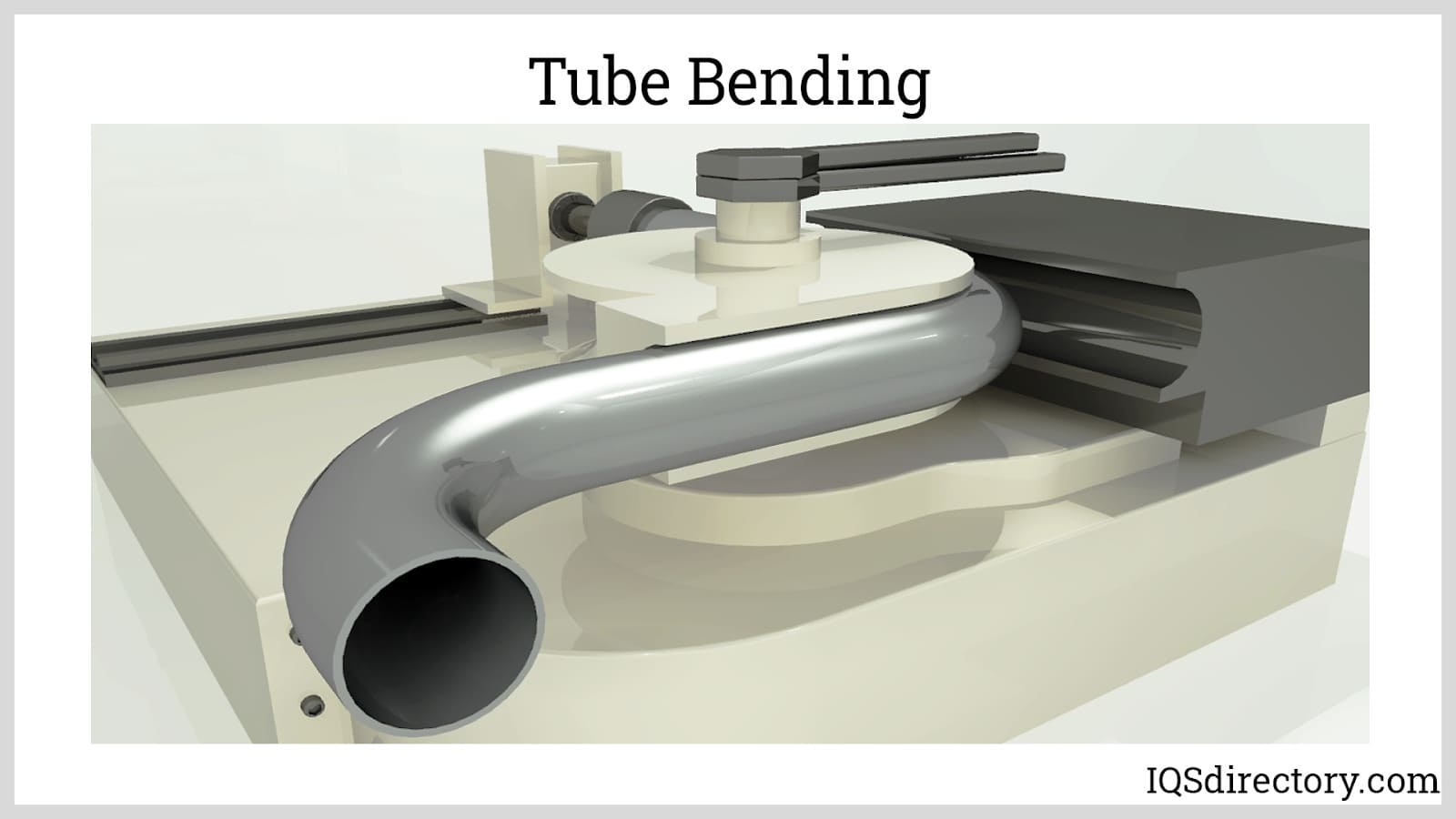 Tube bending is a mechanical process that transforms straight tubes into curved forms.
Tube bending is a mechanical process that transforms straight tubes into curved forms.
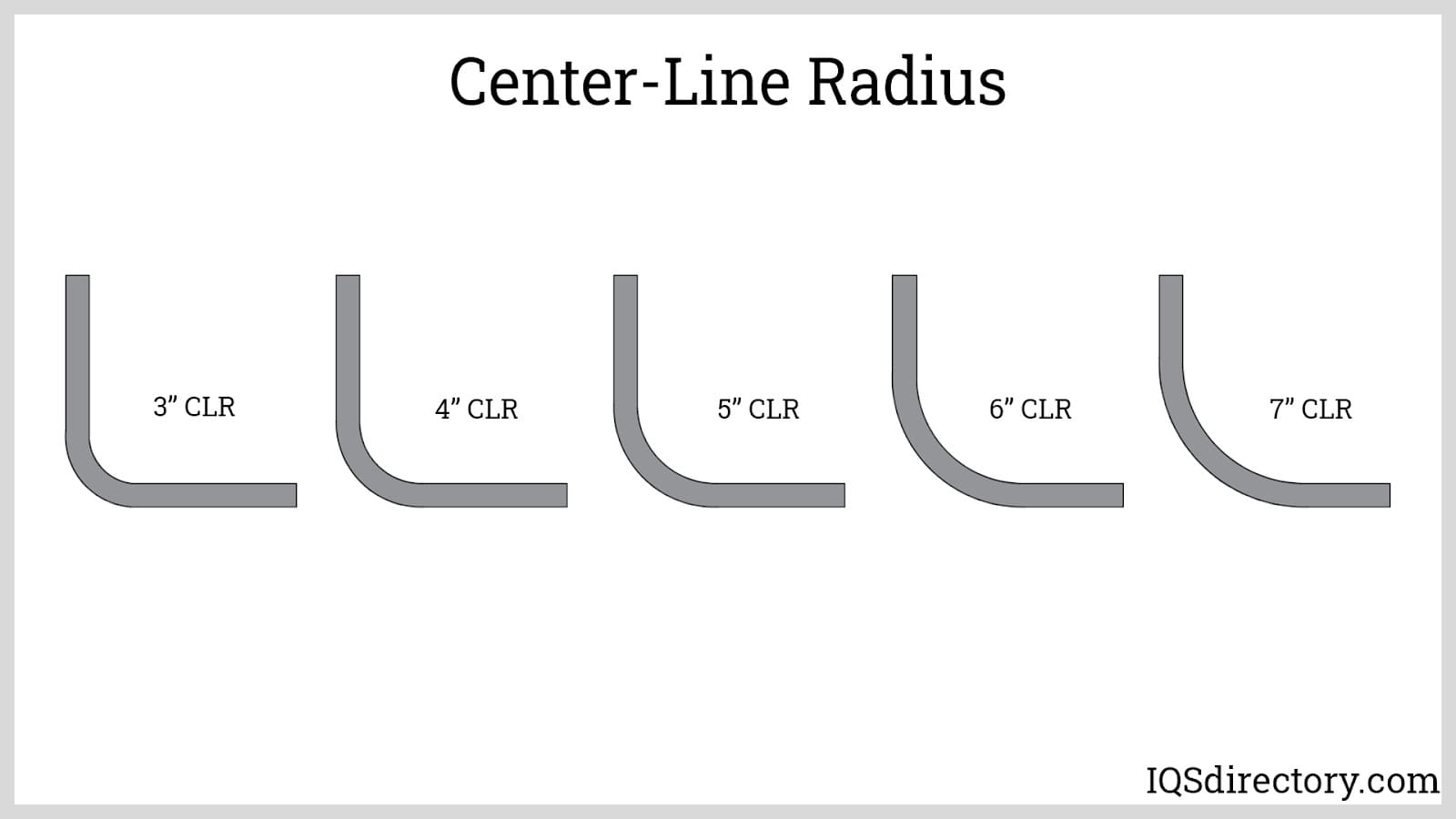 The center-line radius measures the distance from the curve’s center to the centerline of the tube.
The center-line radius measures the distance from the curve’s center to the centerline of the tube.
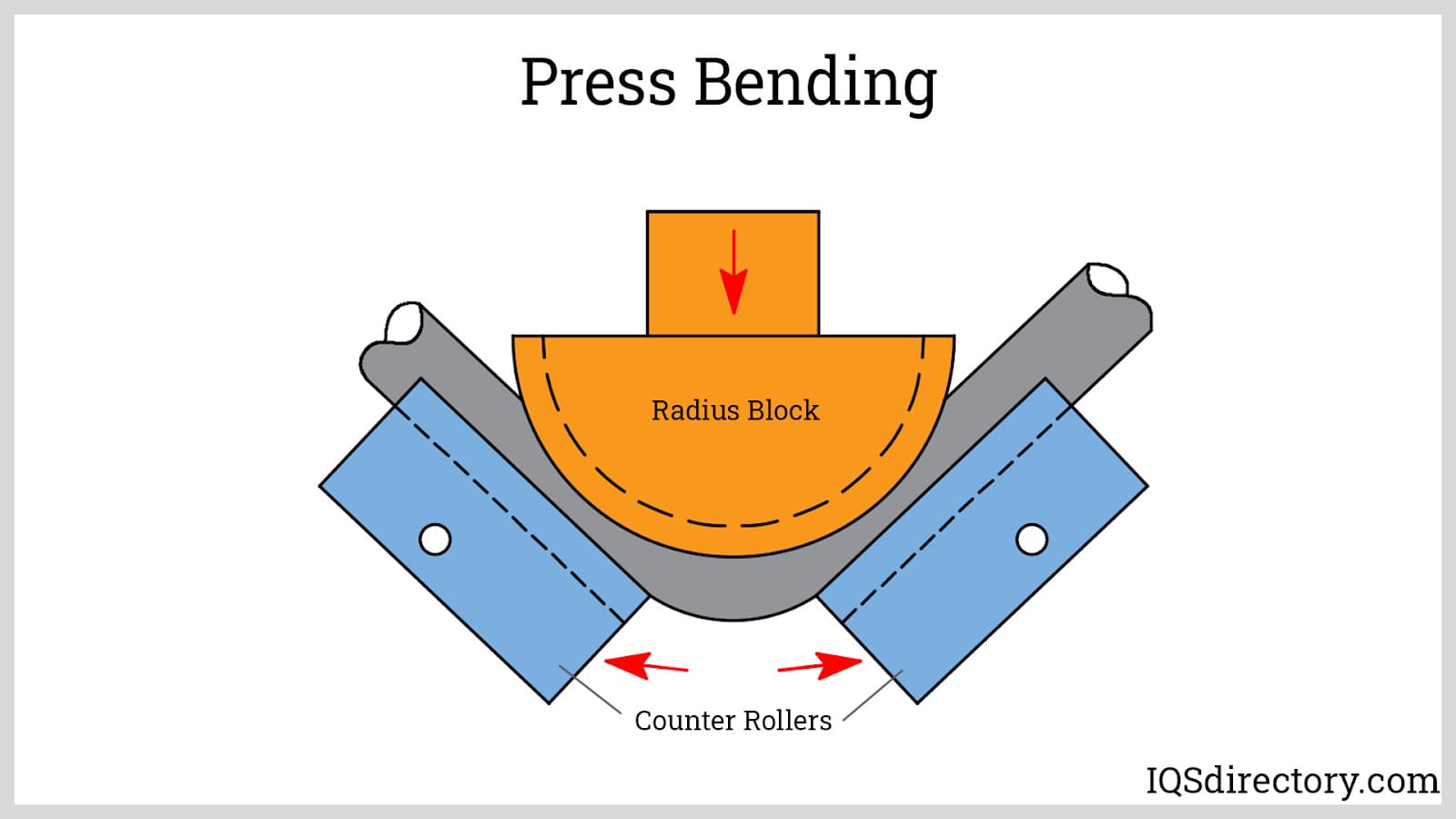 In press bending, the tube is held at two points while the bend die forces it into a curved shape.
In press bending, the tube is held at two points while the bend die forces it into a curved shape.
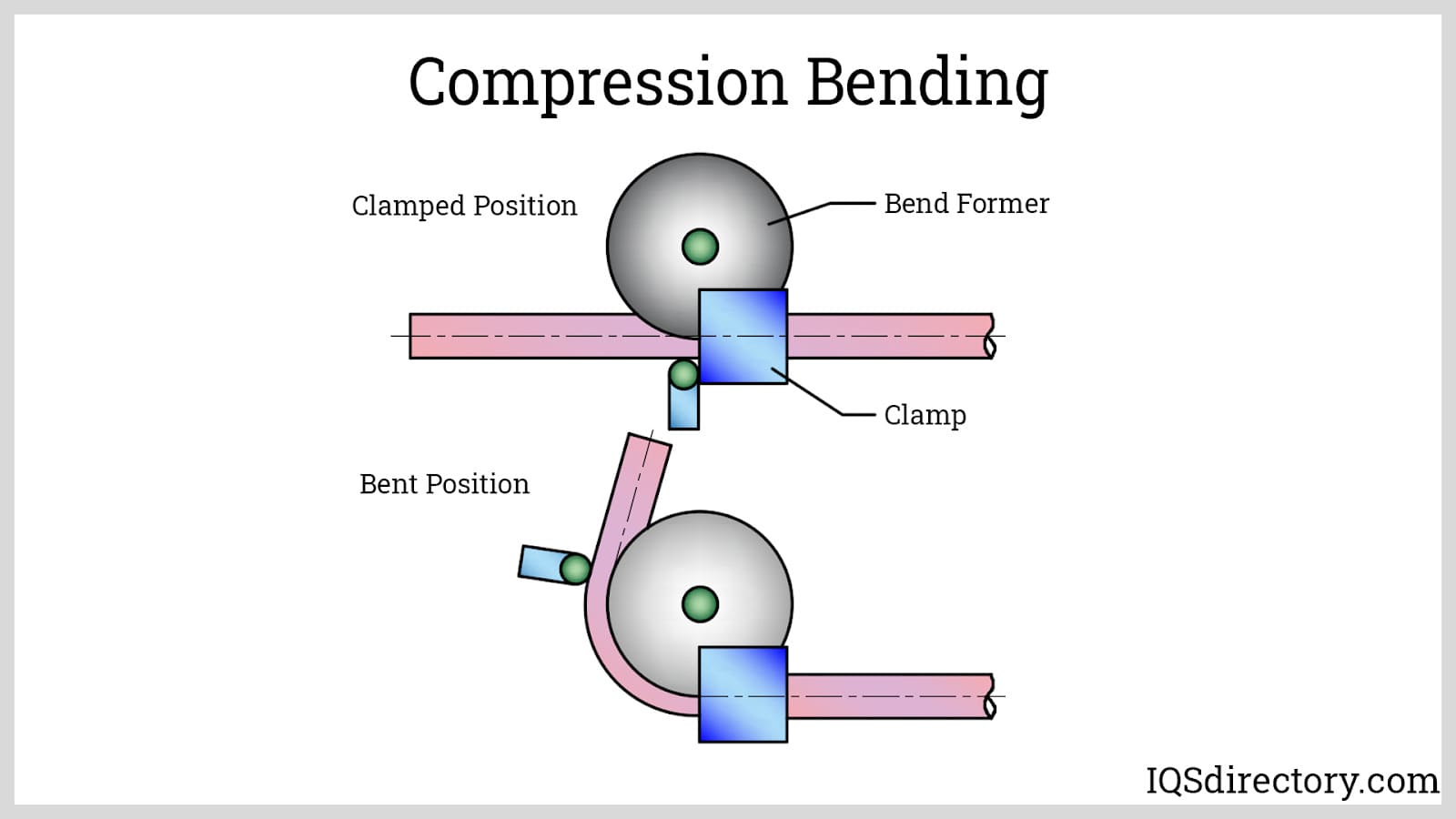 Compression bending is a cost-effective process for circular hollow sections, but is not suitable for all tube shapes.
Compression bending is a cost-effective process for circular hollow sections, but is not suitable for all tube shapes.
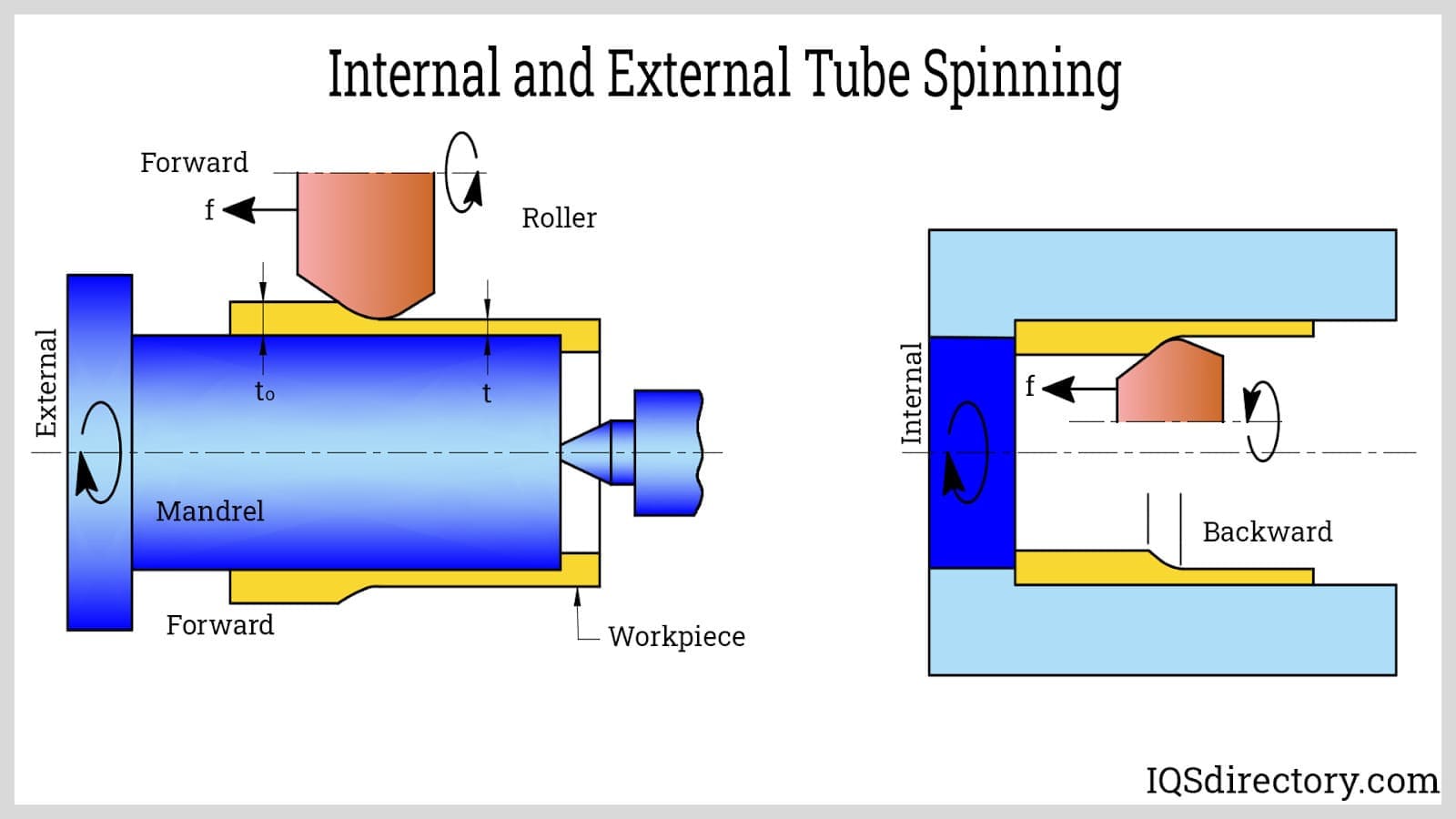 Tube spinning is a flow forming technique that elongates tubes and modifies their wall thickness.
Tube spinning is a flow forming technique that elongates tubes and modifies their wall thickness.
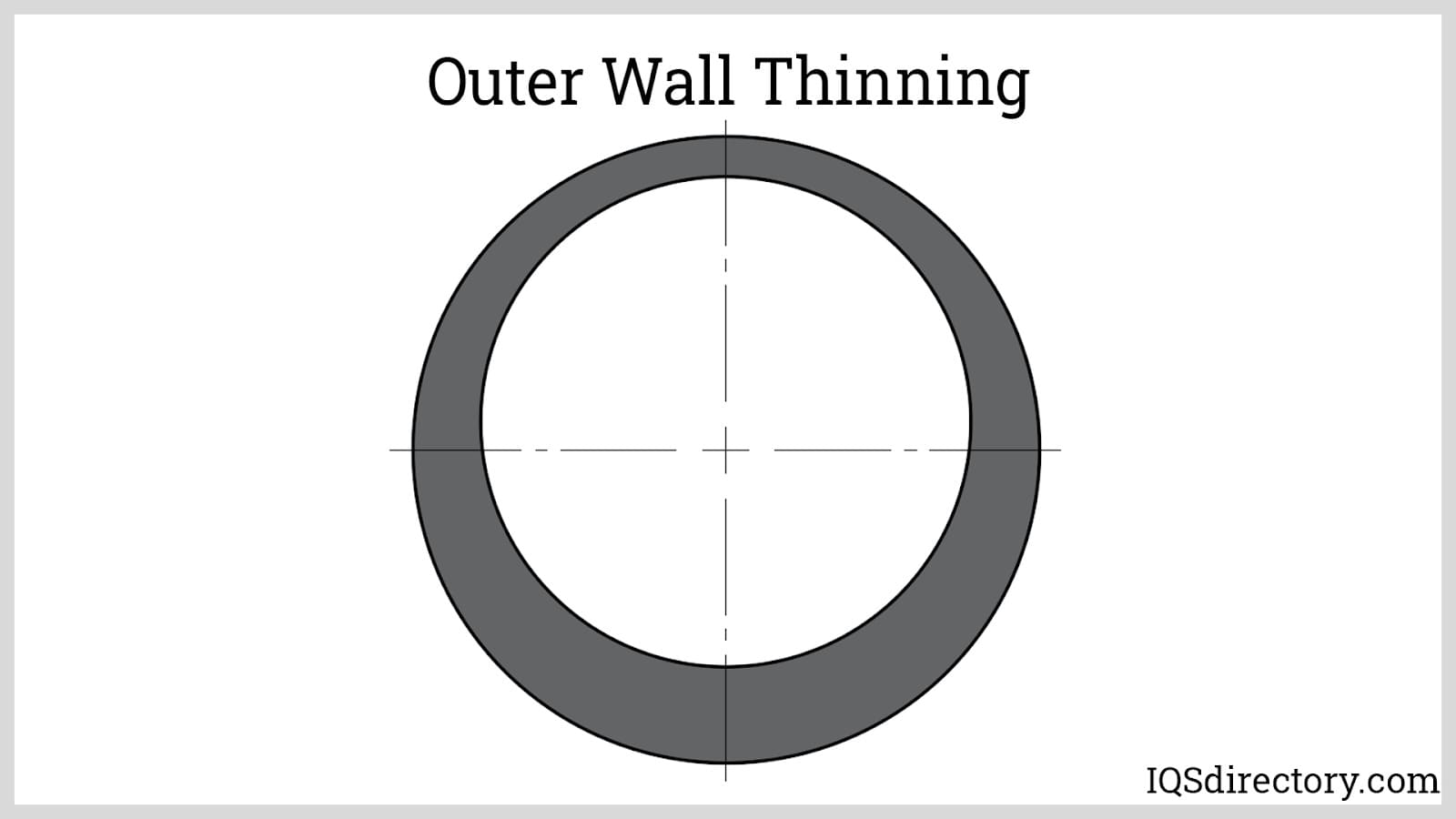 Outer wall thinning occurs when the tube’s outer curve is stretched, resulting in elongation and reduced wall thickness.
Outer wall thinning occurs when the tube’s outer curve is stretched, resulting in elongation and reduced wall thickness.
Tube Fabrication Types
- CNC Tube Bending
- Bends tubes and pipes using computer-controlled machines that ensure the quality and efficiency of a product. Today’s modern CNC technology has made it possible to produce high volume, close tolerance, tubular metal parts quickly and economically.
- Custom Tubing
- Well-known term, referring to any hollow cylinder used to convey fluids or to protect electrical or optical cables and wires. A tube generally has a certain level of rigidity and permanence. This contrasts with the hose, which is generally flexible and portable.
- Hydro-Forming
- A metal fabrication method of forming tubular metal parts within a die cavity. This high-pressure method forces fluids inside the die so that the part expands into its final shape.
- Mandrel Bending
- Also known as mandrel tooling, is a sub-process of tube bending.
- Pipe Bending
- A process that uses computerized machines to bend pipes. Pipe bending can be performed manually using a hand-held mandrel, but most tube fabrication facilities have semi-automated and automated equipment which is faster and more precise. To create a simple pipe bend, the machine clamps down the length of tubing and either forces it to take on the shape of a die or feeds it through rollers.
- Pipe Elbow Fabrication
- Commonly used in flow and hydraulic applications such as plumbing, require both mandrel bending and flaring or swaging. For these types of applications, mandrels are placed inside the tube in the area being bent, or the tubes are packed with sand before the bending process. Mandrels are typically a rounded-tip steel rod, linked ball bearings or unlinked steel balls; the straight mandrel, called a plug mandrel, is used on normal bends, while ball mandrels with linked or unlinked ball bearings are used to form critical precision bends. Mandrels and sand are essential parts of the tube fabrication process as they preserve the interior shape of the pipes around the curve.
- Any tube fabrication process, particularly tube cutting, can result in surface imperfections. If this is the case, manufacturers may finish off your product with sanding or polishing. If they are working with stainless steel tubing, they may also anneal it for strength.
- Pipe Fabrication
- Processes that involve the shaping, cutting, bending or size alteration of pipes formed from various materials for wide-ranging applications.
- Roll Forming Metal
- The tube fabrication process that is most common, although it is not used for thicker metal tubing. It involves rolling a strip of sheet metal and curing it.
- Rotary Draw Bending
- Employs mandrels and various dies to manage and control metal flow during the bending process. In this process, a precision mandrel is positioned inside the tube, while a pressure die, wiper die, bend die and clamp dies surround the outside of the tube.
- Thin Wall Tubing
- Tubing with very little wall thickness, typically ranging from .001 in. (.0254 mm) to about .065 in. (1.65 mm).
- Tube Bending
- Uses computerized machines to bend tubes. CNC tube bender machines, which are often powered hydraulically for extreme torque power, are capable of forming complex tubing shapes such as coils and zigzags with extreme precision and short processing times, although all these processes may still be performed manually on traditional tube benders with longer process times.
- Tube bending performed without a mandrel forms wrinkles in the inside of the tube's curve which can affect the flow capacity of a pipe, and by distorting the interior structure of the pipe create potential weak spots. Although wrinkled tube bends are acceptable for some low-performance and non-aesthetic applications, high performance mufflers, hydraulic piping and decorative handrails require smooth, unobstructed tube bends.
- Tube Cutting
- A process that uses computerized machines to cut pipes and tubes.
- Tube End Forming
- Refers to various processes that are used to shape, cut, bend or enlarge the inside or outside ends of tubing.
- Tube Fabricating
- Employs a variety of techniques to shape, bend, enlarge and cut tubes of all sizes and metals into parts and products.
- Tube Flaring
- A process used to form an extremely tight seal at the end of a tube.
- Tube Forming
- Can refer to several processes that are used to form raw metal materials into tubes.
- Tube Rolling
- The process of producing tubular parts through heat curing materials that have been wrapped around a circular mold, then removing the mold.
- Tube Swaging
- Uses high pressure to shape tubes.
Machinery Used in Tube Fabrication
Common machinery and equipment used during tube fabrication include mandrels, CNC machines, bending dies, roll formers, benders, hydraulic tube benders, CNC mandrel bending machines, swaging machines, coating machines, and more.
For custom tube fabrication, manufacturers can also provide secondary operations such as painting, powder coating, chrome plating, or zinc plating. They are able to produce tubes in nearly any diameter and length to meet specific project requirements.
Things to Consider When Choosing Tube Fabrication
Selecting the best tube fabrication service involves evaluating both the physical characteristics of your tubing and the capabilities of potential manufacturers.
Consider factors such as required production volume, the operating environment, applicable industry standards, ductility, pressure requirements, and the type of material or fluid that will pass through the tubing or piping system.
When choosing a manufacturer, advanced equipment is important, but expertise and quality commitment are equally vital. Look for a supplier focused on delivering high-quality solutions tailored to your needs. Discuss manipulation tests, which assess product quality, with potential partners. The right manufacturer will prioritize your satisfaction—explore the companies listed at the top of this page to find a suitable supplier.
Variations on Tube Fabrication
There are many tube fabrication techniques, each with advantages for specific applications. Precision swaging, for example, is crucial in telescoping tube applications, where one tube must fit smoothly inside another. Industrial and manufacturing sectors also employ fabricated tubing and mandrel bent tubes for hydraulic lines, automotive fuel systems, exhaust pipes, hydraulic cylinders, and shell and tube heat exchangers.
Two key tube bending subprocesses—mandrel bending (also called mandrel tooling) and rotary draw bending—are used to create precise, wrinkle-free bends. During mandrel bending, a mandrel (metal rod or ball) is inserted into the tube as it bends. Rotary draw bending uses mandrels and dies to control metal flow, with a precision mandrel inside the tube and various dies outside to shape the bend. Tubes formed in this way may be called mandrel tubes or mandrel bends.
Tube Fabrication Terms
- Alloy Steel
- Steel that is alloyed with moderate amounts of chromium and other elements, such as molybdenum. Alloy steel is distinguished from stainless steel by good hardening characteristics and from tool steel by possessing better "toughness" after hardening.
- Annealing
- The heating and cooling of steel to remove stresses, alter physical, mechanical and metallurgical properties, increase corrosion resistance and thermally treat steel prior to age hardening.
- Arc
- The curved section of bent tubing.
- As-Welded
- Tubing that is not given heat treatment after the initial welding.
- Austenitic
- A family of chromium nickel stainless steels that have good corrosion resistance and good formability, but can only be hardened by cold working.
- Bend Die
- Less commonly known as the "bend form" or the "radius die," it is the primary tool on a rotary-draw tube-bending machine. The bend die is the form against which the tube is clamped and then drawn around to produce a bend.
- Bright Annealing
- The process of annealing in a controlled atmosphere so that dark, adherent oxides do not form on the metal.
- Burst Pressure
- The amount of pressure that will make tubing fail or burst by exceeding the tensile strength of the material from which the tubing is made.
- Camber
- A measure of warp in tubing material or the deviation from straightness.
- Cold Drawing
- The normal method of rotary-draw tube-bending, which is done without heating the tubing material.
- Ductility
- A measure of a tube's ability to deform without fracturing.
- Elongation
- The amount of permanent extension of the material before it fractures.
- Full-Finished
- A term that refers to the state of the tube after the weld has been processed to produce uniform strength and dimensions and the tube has been annealed for corrosion resistance.
- Manipulation Tests
- Tests used to evaluate the quality of finished products, such as crush, flare, bend, flange, flatten, reverse flatten, reverse bend and expanding.
- Ovality
- The deformation of round tubing into an elliptical shape or a symmetrical flattening of a round tube. Ovality is the measure of the difference between the maximum and minimum outside diameters of a round tube.
- Passivation
- A protective layer made of oxides, which is on the outside of tubing, that resists corrosion.
- Pickling
- The chemical removal of oxides on the surface of metals.
- Pressure Tubing
- Tubing specified for the containment of liquids and gasses, as opposed to structural or mechanical purposes.
- Tangent
- The unbent section of a bent tube.